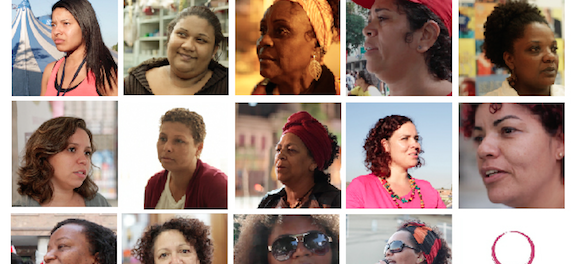
A documentary produced by the organization House of the Working Woman (CAMTRA – Casa da Mulher Trabalhadora) documented the impact of the 2014 World Cup on women in Rio de Janeiro. In a short 20-minute film called “The World Cup and Women,” interviews with 14 women from the city reveal what it was like during the mega-event’s month for street vendors, businesswomen, prostitutes, activists, artists and favela residents.
For some women, the mega-event had negative effects: prostitutes and street vendors earned less money during the championship. For others, the city remained the same in spite of promises from the government that they would all benefit from the competition. The whitening of Brazil during the World Cup was also a topic discussed, as was the exploitation of the female body to attract tourists to the Marvelous City, as Rio de Janeiro is known.
In an interview with RioOnWatch the documentary’s director, Amanda Palma, and the general coordinator of CAMTRA, Eleutéria Amora, explain the objective of the documentary and how it was made. Check out the full interview below.
Where did the idea to make the documentary come from?
Amanda Palma: The idea was entirely CAMTRA’s, with the aim of dispersing information which benefits the fight for women’s rights.
Eleutéria Amora: The idea of the documentary came about because we wanted women to speak out about how their lives were being affected by the organization of the Cup in Brazil and how it was a myth that everyone, the whole country, would gain a lot with this mega-event. In fact many people made money, but these people certainly were not the working women.
How did you choose women to interview?
AP: The women were selected jointly with CAMTRA, which has a large network of women already known to the organization, so that we could have a wide range of women with different struggles. We have women from diverse social movements ranging from the circus, occupations and workers from different sectors. Everyone was receptive mainly because they trusted the work of CAMTRA and they knew their words would not be misrepresented.
Why is it important to bring visibility to the impact of the World Cup on the lives of women?
AP: Mainstream media is very partial to always announcing large events as a party and principally as an opportunity to enrich the country. With this, we realized many people become hopeful that their ‘lives will change’ during this period. It is important to reflect about exactly which part of the population is benefiting from these events.
EA: The idea of a city-for-sale and not a city for the people. And women are the most affected because it is they who face every type of daily problem, facing the deficit of public services in their daily lives. Like daycare, education and health. And so the question remains: why invest in an airport, in large avenues, security–who are those investments for? They’re just for an elite who remain in power and who probably managed to buy tickets and watch the Games, because for the people that wasn’t possible.
Many women speak about the whitening of the city during the Cup. Why did you think it was important to talk about this?
AP: I highlighted everything I considered most prominent in the discourse of each [woman], with care to show their points of view and not to turn the documentary into my point of view. This question about the whitening was very strong and addressed by several women. People who discovered Brazil through pictures of the Cup that were circulating around the world saw a white country. From the commercials of the Cup to the crowds who were in the stadium watching the match, you almost never saw black people. This segregation was very obvious, whereas in reality and on the streets we know that Brazil has a black majority population.
One of the interviewees said the Brazilian woman’s body is used to sell Brazilian tourism to the world and the documentary portrays women as real workers who are affected by the event for this reason. Was this the contrast that you were looking for in producing the film?
AP: I started to produce the film without any specific expectation; I just let the interviewees be free to answer the questions as they pleased. We ended up with this clear contrast, which is an example of how a male-dominated society functions. In the case of the World Cup, women are overly used in the media as a sexualized way of ‘attracting’ tourists to the country, but at the same time working women are left to the side and don’t receive any of the benefits that come with these investments. For example, we had the case of the company Adidas which produced t-shirts with sexist content where they were literally offering the body of a Brazilian woman as if it were here for tourists’ disposal. Thanks to pressure from online critics, notes of condemnation from diverse social movements and, in the end, from the government, the company canceled the sale of the t-shirts. This was the result of the joint effort of many feminists making sure this subject was heard.
What is the desired impact of the documentary?
AP: I believe that everyone, especially women, can watch the testimonials of the interviewees and seek to develop some critical thinking. If you ask the ‘why’s’ of things that could pass by unnoticed, question things… As many women say in the documentary: it’s not enough to be a woman, you must seek to understand, criticize, unite, reclaim and demand your rights and your place in society.
EA: We hope it serves as an inspiration for the fight, an aid for reflection about the situation of working women in this country, and as an instrument for the struggle.
